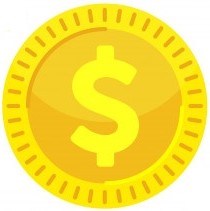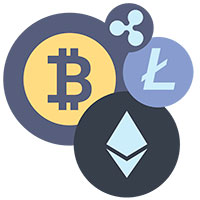Rumors of a new, gold-backed international currency by BRICS are circulating, alongside fears that it will spell disaster for America and the dollar as international legal tender. But, how likely is it really, and when might it happen? If you trade XAUUSD and other US-related assets, this article just might be your most important read of the year.
How gold used to set the standard
Currencies today are not backed by anything of tangible value, meaning that a nation can simply print more when it needs more… and some do that a little too much. It’s one of the reasons why inflation is rampant in certain countries. But it wasn’t always like that. There was a time when something called the Gold Standard guided economies. To simplify the Gold Standard, nations set the price of gold by calculating how much of their currency was in circulation, compared with how many ounces of gold they kept in reserve. If more gold was acquired, more money could be printed.
Gold is a precious metal that never corrodes, and cannot be counterfeited or replicated. It’s the perfect manifestation of value in a malleable, eternal form that supported stable and sensible economies for centuries… until 1945.
The Bretton Woods agreement
In July 1944, 44 Allied nations gathered in Bretton Woods, New Hampshire, USA to design a new international monetary system that would facilitate post-war reconstruction. After World War II, the United States emerged as a major economic and industrial power. Its strong and stable economy was backed by abundant resources and infrastructure that remained largely intact during the war. As a result, USD was seen as a reliable and secure currency, making it an attractive choice for other countries to hold as reserves.
Under the Bretton Woods system, gold was set at a fixed rate of $35 (USD) per ounce, and the standard was born.
How the US broke its promise to the world
Nations sent gold to America by the boatload, and the US Treasury kept the bullion safe. In return, those nations received USD at the $35 fixed rate. International trading began and the Bretton Woods system was celebrated. Central banks could return surplus USD to the US and receive gold at the standard rate whenever they desired. The dollar was literally “good as gold” and confidence in America was at an all-time high.
That all changed on 15 August 1971, when US President Richard Nixon announced the suspension of the dollar's convertibility into gold. That decision, known as the ‘Nixon Shock’ was in response to a growing trade deficit and increasing international speculation against USD.
As a result, countries could no longer recover their gold by returning their dollar holdings to the US. Gold from 46 nations was kept locked away in America’s Fort Knox and several Federal Reserve Banks around America, with international access simply denied. It was a dirty trick played on the world that most seem to have forgotten about.
Why the US abandoned the agreement
During the late 1960s, the United States experienced a significant trade deficit, which meant that the country was importing more than it was exporting. This led to a disturbing outflow of USD. At the time, the US faced a triple whammy of domestic economic challenges, rising inflation, and a costly war in Vietnam. Concerns over USD stability and negative speculation were on the rise, and some countries doubted the US could maintain its commitment to converting dollars to gold at the $35 per ounce fixed rate.
And so a ‘gold drain’ ensued, similar to a bank run, in which central banks around the world began converting their surplus dollars back into gold. The White House panicked and broke an agreement that had been in place for almost three decades.
Gold prices doubled overnight and in less than a decade rocketed by 1825%, making it impossible for nations to buy back their gold using their surplus USD. And so, nations were forced to continue using the dollar as a reserve currency. Which brings us to today.
Tides are turning: the de-dollarization speculation
Many economists believe that de-dollarization is a fairytale being told around traders’ campfires. But to understand if an alternative to the USD reserve really is on the cards, we should start by asking: is there a good reason to create one? It’s not hard to imagine the appeal. An independent currency, not tied to one nation’s economy or government, is an attractive proposition. Countries wishing to trade with others wouldn't need to give up valuable goods or commodities in order to receive stacks of paper that might lose their value overnight.
US Media loudly insists the dollar is a safe choice. But is it? And for whom? Not for a country that finds itself on America’s naughty list and at the mercy of White House policy – ‘mercy’ not being a quality America is famous for. The US controls the Swift international payment system, which allows it to weaponize international monetary transfers at the push of a button. Many countries have had their economies held to ransom in this way by US sanctions over the last 50 years.
Iran, Cuba, North Korea, Russia, Venezuela, Syria, Myanmar, Zimbabwe, Sudan, and China have all at some point refused to yield to America’s interests and found themselves sanctioned. But there are other economically weak countries that have simply bowed to US pressure after being threatened with restrictions.
And of course, countries relying on and holding USD have seen their national wealth diminish as their precious commodities are passed on to the US, in return for paper of questionable value. That value has been dropping year after year as the US debt ceiling broke and expanded, with trillions of dollars printed and dispatched to balance international debt. USD's true devaluation is undeniable, but is only felt by other nations. The US has kept its economy afloat on debt, through a scheme of essentially borrowing money from one to pay another over and over again. But such a system cannot last forever, and our generation may be the one to see this socioeconomic house of cards collapse.
The European Union is where de-dollarization would begin
Surely the EU, that long-standing US ally, will not abandon the dollar? Despite the ‘Nixon Shock’, Europe has remained economically tied to the US for decades. But has that been a fair and amicable arrangement? In 2008, the EU’s economy was 10% larger than the US. Fast forward to 2024 and US GDP is projected to be 50% larger than all of Europe’s combined, exceeding $25 trillion. Even strong and loyal allies are feeling the sharp end of the USD stick now.
The White House claims its allies are unwavering, but against its wishes, Japan has already started buying oil from Russia, and France’s President Macron is rumored to be attending the next BRICS summit on 22 August.
Skeptics say that another currency cannot replace the dollar because not enough countries will adopt it, but that theory is weakening with every passing month. As of 2024, USD is forecast to be used in around 47% of international trades: but that number is already falling, even before an alternative currency is available. What then, will that number be after BRICS release a gold-backed currency?
The five BRICS countries represent a substantial 40% of the world's population. If you add the 30+ countries currently applying for BRICS membership, that rises to well over 50%. If all of these countries start to partially use BRICS currency instead of USD, the rest of the world will likely follow, purchasing some of the currency in order to trade with the 37-nation alliance. And in a domino effect, dollar foreign reserve holdings would most likely plummet.
When might we see this mythical currency?
While some sources suggest the new currency could be announced at the next BRICS Summit, others say the five nations are some way from revealing this new world order. The rumor began several years ago, but got its first official endorsement last month when deputy chairman of Russia's State Duma (lower parliamentary assembly) Alexander Babikov told reporters that the BRICS alliance was creating a new currency backed by gold and other precious commodities.
But India’s foreign minister S. Jaishankar recently said there were no immediate plans to introduce a currency, stressing that a BRICS currency would continue to be “a matter of national concern” for India for the foreseeable future.
India's perspective is shaped by its own unique economic circumstances and geopolitical considerations, relying on trade relationships with the West and being afraid of an economic standoff with the US. Moreover, there are historical tensions and disputes between India and China that could be influencing India's approach to the alliance. India is wary of China's power and motives, and fears that the BRICS alliance might become too China-centric.
Conclusion
So we have Russia saying a BRICS currency is coming, India saying not yet, China pushing for it, and dozens of countries asking for it. An alternative to USD is coming, and it might be soon. Given what Nixon did to 46 nations, it’s not hard to imagine how the US will react. De-dollarization might be the perfect excuse for the US to default on its $33 trillion international debt, and with the Fed now pushing to create a fully digital American economy, this really could be the end for USD. But this is all campfire speculation… until it isn’t.
When the US broke its promise and ditched the Gold Standard, nobody could believe it and nobody saw it coming. Such a massive decision wasn’t made overnight, so secrets were kept until the last moment.
The US is once again facing domestic economic challenges, including rising inflation and a costly war intervention, similar to what influenced America’s betrayal five decades ago. If history is repeating itself, then a paradigm shift is surely on the horizon. But de-dollarization won’t happen overnight. Implementing a gold-backed currency would require addressing some heavy logistical challenges first. For instance, deciding where to store the physical gold reserves and ensuring their security and accessibility would be crucial. The obvious and easy option would be to create a gold-backed cryptocurrency, but so far, a ‘crypto’ approach to the BRICS currency has not been publicly discussed.
Gold distribution among BRICS would also need to be carefully considered to avoid concentration of power in any one country – the very thing the nations are trying to eliminate. The coming BRICS Summit might bring some clarity to the speculation. You can be sure that an announcement, or lack thereof, will affect the market either way, so be ready.
Gold is an obvious asset that will feel the ripples, so traders will want to keep a close eye on XAUUSD over the coming weeks. American entrepreneur Robert Kiyosaki is also advising investors to snap up gold, alongside Bitcoin, which he predicts will surge to a staggering $120,000 by the end of this year. There’s zero evidence or mathematical reasons for such a number, so that might simply be an attempt to cause hype.
The truth is that we are in a phase of economic exploration and evolution, and only time will tell. One thing is for sure though: whenever there’s a financial paradigm shift, some people barely survive, while others thrive and profit from the historic moment.
Trade with Exness and enjoy security and confidence, no matter how volatile the markets get.
















